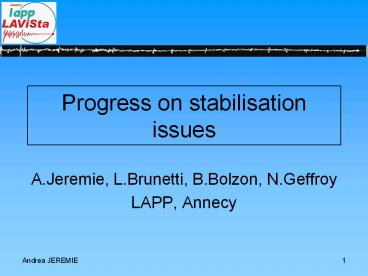Progress on stabilisation issues - PowerPoint PPT Presentation
1 / 22
Title:
Progress on stabilisation issues
Description:
Active stabilisation = simulation and experimental results ... Compatible Matlab/Simulink (Softwares used for the algorithm) nm stabilisation equipment exists ... – PowerPoint PPT presentation
Number of Views:15
Avg rating:3.0/5.0
Title: Progress on stabilisation issues
1
Progress on stabilisation issues
- A.Jeremie, L.Brunetti, B.Bolzon, N.Geffroy
- LAPP, Annecy
2
Program
- Introduction
- Nanometre scale instrumentation
- Active stabilisation gt simulation and
experimental results - Combine passive and active stabilisation
- Conclusion
3
- Introduction
4
Beam sizes in the nanometre range
The CLIC luminosity performance critically
depends on the main linac quadrupole vertical
stability (lt1nm _at_ 1Hz) and the final doublet
stability (lt0.1nm _at_ 4 Hz) in noisy site
Linac
1.3nm
FF
0.2nm
Measurement of the quadrupole vibrations on
active table in vertical direction compared to
linac and Final Focus (FF) tolerances at 4Hz (in
2003)
4 Hz
S.Redaellis PhD 2003
5
Introduction
Example of spectral analysis of different
disturbance sources
- Ground motion
- Acoustic disturbance
A pink noise on a large bandwidth
Seismic motion
Cultural noise
- Amplified by the structure itself the
eigenfrequencies
gtneed to isolate and compensate
6
- Nanometre scale instrumentation
7
First results of stabilisation in the nanometre
scale
Experimental set-up
Feedback input Sensor at the free-part of the
beam
Feedback output Actuator at the fixed-part of
the beam
PCI6052 DAQ Sensor acquisition and actuator
control
8
State of the art inertial sensors
- NI PCI-6052 Multifunction DAQ
Fast card
Low noise card
- Compatible Matlab/Simulink (Softwares used for
the algorithm)
nm stabilisation equipment exists
9
- Active stabilisation gt simulation and
experimental results
10
Active compensation
The prototype
- The large prototype and its instrumentation
2.5 m long
- Actuators used for the active control of
vibration
- Force 19.3 N
- Maximal displacement 27,8 µm
- Resolution 0,28 nm
- A stacking of PZT patches -
11
Why a fixed-free configuration?
12
Active compensation
Another approach of the problem
L.Brunetti
- Test an intermediary solution to control a
larger bandwidth
A local model of the process
A local model of the process
A complete model of the process
A knowledge of the process at strategic points
f0
f1
fi
1 - A complete model of the structure too
complex
2 - A knowledge of the structure at strategic
points the initially developed algorithm
3 - A local model of the structure for the
disturbances amplified by eigenfrequencies.
13
Brief summary
Results
Rejection of 6 resonances (without and with
rejection)
by L.Brunetti
Resonances of -beam -support
14
Active control CIM
Tests in simulation
- Integration of a finite element in a feedback
loop
15
Active control CIM
Tests in simulation
- Integration of the finite element model in the
feedback loop
- Example of result
16
Active control CIM
Tests with the large prototype
- Results Power spectral density
17
Active control CIM
Tests with the large prototype
- Results integrated displacement RMS
18
Tests with the large prototype quiet room
integrated displacement RMS (with active table ON)
1 nm
Actuator electronic noise at 50 Hz
Combining isolation and compensation
19
Combine passive and active stabilisation
20
Active isolation
Reasons of this study and the STACIS feet
- In the case of a possible partnership, we have
no competence about active isolation. - In the case of the development of a low cost
table (this one is very expensive), we have no
information about the mechanism (mainly the
feedback loop). - STACIS foot
(Thesis of S. Redealli)
- Passive isolation attenuates all the high
frequency disturbances but amplifies the low
frequency disturbances (like a resonant filter). - Active isolation attenuates the disturbance
amplified by the passive isolation (low
frequencies disturbances).
- Test of active isolation on a small mock-up
21
Active isolation
The small and elementary mock-up
- Association of active and passive isolation
- The passive layer
Require active isolation ?f
Passive isolation is efficient
Resonant frequency of the rubber
? Not heavy enough to use industrial products,
but it is possible with a larger prototype.
22
Conclusions
- Hardware
- Acquisition chain able to measure at a nanometre
scale - Actuators to create nanometre displacements
- A real time solution to run automatics algorithm
- Control
- 2 types of algorithms for active compensation
- A beginning of study for active isolation
- We have succeeded in stabilizing an elementary
structure at a nanometre scale with a natural
environment.
- Future prospects
- The purpose now is to obtain the best possible
stabilization all along the elementary mechanical
structure (lower or equal to the imposed
tolerance)































